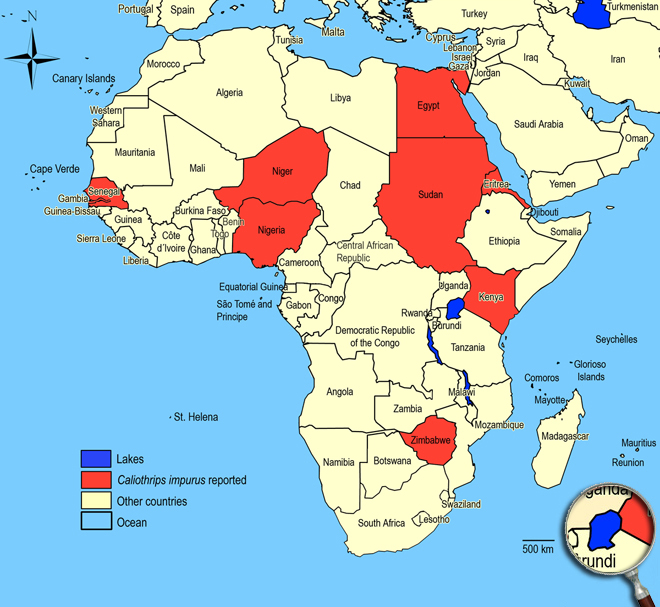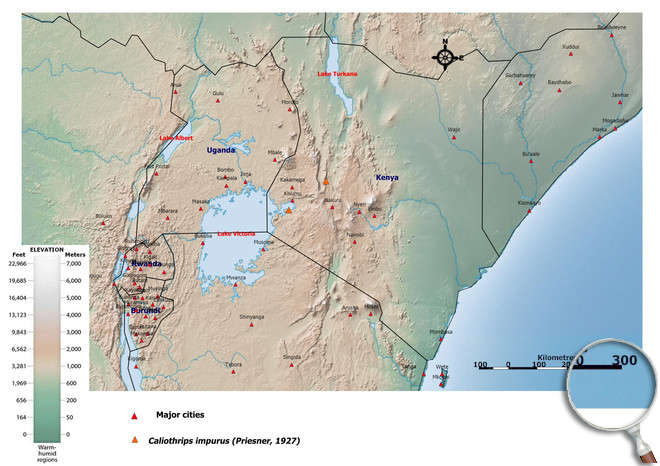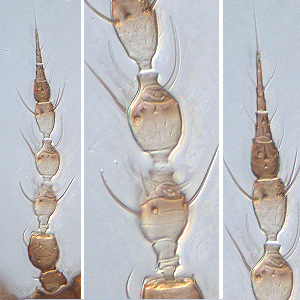Caliothrips impurus (Priesner, 1927)
Panchaetothripinae, Thripidae, Terebrantia, Thysanoptera
Figures
Fig. 1: 8-segmented antenna, segments III and IV with forked sense cone, terminal segments V-VIII
Fig. 2: Head dorsal with ocellar triangle
Fig. 3: Pronotum
Fig. 4: Meso- and metanotum
Fig. 5: Meso- and metasternum with lyre-shaped furca
Fig. 6: Fore- and hind wing, fore wing distal region
Fig. 7: Tergites IV-VI
Fig. 8: Tergite V, lateral region
Fig. 9: Tergite VIII
Fig. 10: Tergites IX and X
Introduction and recognition
Caliothrips impurus causes damage in a range of crops, including seedling cotton, groundnut, and onion. Female macropterous; body dark brown; all tarsi and bases and apices of tibiae yellow; antennal segments dark brown, III-V yellow with apical half light brown (Fig. 1); fore wings brown, largely dark with small patches sub-basally and sub-apically, with extreme apex dark (Fig. 6). Antennae 8-segmented; segments III & IV with long forked sensorium (Fig. 1). Head not constricted at base (Fig. 2). Pronotum without long setae, with irregular longitudinal reticles and many markings within each reticle (Fig. 3). Metanotum irregularly reticulate, one pair of major setae near anterior margin (Fig. 4); metafurca elongate and lyre-shaped (Fig. 5), mid and hind tarsi elongate but 1-segmented. Fore wing first vein close to or fused to costal vein; fore wing second vein with about 5 setae; costal cilia shorter than costal setae (Fig. 6). Lateral sculpture on tergites broader polygonally reticulate and with markings in between (Fig. 7 and 8); tergite VIII with craspedum medially, tooth-like microtrichia laterally (Fig. 9); median split on X about half as long as tergite.
Male tergite IX with 3 pairs of stout setae medially; sternites III-VII with long, narrow transverse glandular areas.
Taxonomic identity
Species
Caliothrips impurus (Priesner, 1927)
Taxonomic history
Hercothrips impurus Hood, 1940
Hercothrips fumipennis Bagnall & Cameron, 1932
Heliothrips impurus Priesner, 1927
Common name
Dark cotton leaf thrips
Present taxonomic position
Family: Thripidae Stephens, 1829
Subfamily: Panchaetothripinae Bagnall, 1912
Genus: Caliothrips Daniel, 1904
Genus description
The genus Caliothrips Daniel, 1904
The genus Caliothrips currently includes more than 20 species. Members of this genus are dark brown, head and pronotum with a heavy net-like sculpture and with internal markings inside each reticle. Head without neck and dorsal ridge. Fore wings banded (usually dark with pale areas) and antennae with 8 segments, and forked sense cone on antennal segments III & IV. Most of the species in this group are found living in grasses and legumes (Mound & Kibby 1998).
Species description
Typical key character states of Caliothrips impurus
Coloration and body sculpture
Body color: mainly brown to dark brown
Sculptured reticles on head and pronotum: with internal sculptured markings
Surface of head, pronotum and fore legs: with heavy, often polygonally reticulate sculpture
Antennae
Number of antennal segments: 8
Form of sense cones on antennal segments III and IV: emergent and forked on segments III and IV
Forked sense cone on antennal segment IV: extending to a point at least a third to base of segment V
Terminal antennal segments: VI-VIII forming a single unit
Head
Cheeks shape: without constriction posteriorly
Head - occipital ridge dorsally: absent
Head: not prolonged in front of compound eyes
Ocelli: present
Prothorax
Pronotal blotch or internal apodeme: absent
Pronotum shape: broadly rectangular
Pronotum surface: with longitudinal reticulate sculpture
Mesothorax
Mesonotum: with an incomplete median division
Metathorax
Metanotum with dominant sculptured triangle medially: absent
Shape of metathoracic furca: elongate and lyre-shaped
Wings
Fore and hind wings: present, more than half as long as abdomen (macropterous)
Fringe cilia arising: from sockets
Fore wing veins: present
Fore- and hind wing surface: covered with microtrichia
Apex of fore wing: with prominent terminal setae
Fore wing anterior margin (costal vein): with setae and cilia but setae longer than cilia
Fore wing costal fringe cilia: arising at anterior margin of wing
Fore wing first vein: close to or fused to costal vein
Fore wing first vein setal row: incomplete, with setae not closely and uniformly spaced
Fore wing number of setae of second vein: 5
Fore wing second vein setal row: complete, setae uniformly spaced
Fore wing shape: mainly parallel sided or margins run continuously towards each other
Fore wing surface: not reticulate
Fringe cilia on posterior margin near apex: distinctly wavy (undulated)
Length of fore wing costal setae at middle of wing: longer than half of median wing width
Shape of fore wing apex: with mainly posterior margin curved to join anterior margin
Fore wing extreme apex color: dark
Fore wings: alternating bands of dark and light
Legs
Mid and hind tarsi: with one segment
Color of fore tarsi: pale or yellow, sometimes apically shaded or brown
Abdomen
Sculpture of lateral thirds of tergites III to VI: with broader polygonally reticulate sculpture with internal wrinkles
Tergites: without distinctive tergal sculpture forming a series of arches on the antecostal ridges
Tergite II: without numerous recurved claw-like microtrichia anterolaterally
Tergites III to VI sculpture on lateral thirds: comprising mainly oblique reticulations
Tergites IV and V median setal pair: shorter than distance between their bases
Tergites VIII to X: without unusually long and stout setae
Tergite X: not tubular, longitudinally incomplete
Setae on abdominal tergite X: all setae slender

Similar or related species
Caliothrips impurus is similar to Caliothrips fasciatus, both with tergites sculptured on lateral thirds comprising mainly polygonal reticulations and numerous internal wrinkles. Caliothrips impurus has a broader polygonally reticulate sculpture, whereas Caliothrips fasciatus has mainly angular oblique reticulations. Tergites of other Caliothrips species (Caliothrips graminicola, Caliothrips phaseoli and Caliothrips sudanensis) shows a transverse striation with or without internal markings on lateral thirds. Compared to Caliothrips sudanensis with pale extreme apex on fore wings, other species have a dark extreme apex. Caliothrips fasciatus is the only species with sculptured pronotum with mainly equiangular reticulations (other species with irregular longitudinal reticulations).
In Caliothrips fasciatus and Caliothrips graminicola the forked sense cone on antennal segment IV scarcely extends beyond base of segment V, whereas in Caliothrips impurus, Caliothrips phaseoli and Caliothrips sudanensis the forked sense cone on antennal segment IV extends to a point at least a third to base of segment V.
Members of Caliothrips can be recognised by their reticulate sculpture that bears internal markings. Only Retithrips syriacus has also complex markings within each of the reticles, and fore wings bearing anteromarginally 3 curious blister-like callosities and minute setae. Compared to the closely related genera Hercinothrips and Selenothrips, the head of Caliothrips species is not constricted into a neck. Hercinothrips has 2-segmented tarsi (Caliothrips and Selenothrips with 1-segmented tarsi) and in Selenothrips the hind margin of tergite VIII has a complete comb of long teeth, the pronotum has a transverse striate sculpture and the metanotum a dominant sculptured triangle medially (in Caliothrips and Hercinothrips tergite VIII posteromarginal comb of microtrichia is only present laterally, pronotum with reticulate sculpture, and metanotum without dominant sculptured triangle medially).
Biology
Life history
As with other thrips species the life cycle from egg to adult is dependent on temperature. The full cycle can take about 15 days (Lewis 1973) to over a month and adults may live for more than one month producing several generations in one year depending on seasonal weather.
Host plants
Crops: alfalfa, beans (garden beans, hyacinth bean, Egyptian pea), berseem (Trifolium alexandrinum), cotton, groundnut, onion.
Vector capacity
None identified, but possible mechanical distribution of phytopathogenic fungi and bacteria.
Damage and symptoms
-
Detection and control strategies
-
Additional notes
-
Biogeography
Africa. Egypt, Eritrea,
Gambia (Yandum, Sapu),
Kenya (Nyanza and Rift Valley provinces), Niger (Diadia, Madaoua),
Nigeria (Lagos, Raba - Niger Province; Ibadan),
Senegal (Fété Olé),
Sudan (Khartoum, Mitaleib, Medani, Hag Abdalla, White and Blue Nile Province, Kassala Province, Fung Province),
Zimbabwe (Nyanyadzi Irrigation Scheme - 25 miles north of Birchenough Bridge, Chipinga).
African countries where Caliothrips impurus has been reported

Occurence of Caliothrips impurus in East Africa

Please click here for survey sites of all observed thrips species of Kenya, Tanzania and Uganda.
Click here for locations of Caliothrips impurus in parts of East Africa.

Bibliography
Bagnall RS & Cameron WPL (1932). Descriptions of two species of Hercothrips injurious to cotton in the British Sudan, and of an allied species on grass. Annals and Magazine of Natural History, Zoology, Botany and Geology. (Serie 10) 10: 412-419
Bournier JP (2002). Les thysanoptères du cotonnier. Les déprédateurs du cotonnier en Afrique tropicale et dans le reste du monde, No. 12. CIRAD-CA, Montpellier, 104 pp
Faure JC (1962). Thysanoptera of Africa - 7. Entomologisk Tidskrift. 83 (1-2): 4-43
Hood JD (1940). Two new Heliothripinae (Thysanoptera) from the Transvaal. Journal of the Entomological Society of Southern Africa. 3: 35-41
Kranz J, Schmutterer H & Koch W (1977). Diseases, pests and weeds in tropical crops. Paul Parey, Berlin & Hamburg, 666 pp
Lewis T (1973). Thrips: their biology, ecology and economic importance. Academic Press Inc., London Ltd., 349 pp
Lewis T (1997). Thrips as crop pests. CAB International, Wallingford, 740 pp
Lewis T (1999). Thrips and their control. Pesticide Outlook. 10 (2): 73-77
Mound LA (1968). A review of R. S. Bagnalľs Thysanoptera collections. Bulletin of the British Museum (Natural History), Entomology. Supplement 11: 1-181
Mound LA & Kibby G (1998). Thysanoptera: An identification guide, (2nd edition). CAB International, Wallingford and New York, 70 pp
Palmer JM (1990). Identification of the common thrips of Tropical Africa (Thysanoptera, Insecta). Tropical Pest Management. 36 (1): 27-49
Pitkin BR & Mound LA (1973). A catalogue of West African Thysanoptera. Bulletin de ľInstitut Fondamental ďAfrique Noire, Série A. 35 (2): 407-449
Priesner H (1927). Neue und weniger bekannte Thysanopteren, gesammelt in Westafrika von Prof. Dr. F. Silvestri. Bollettino del Laboratorio di Zoologia Generale e Agraria della Facoltà Agraria in Portici. 21 (6): 61-83
Priesner H (1964). A monograph of the Thysanoptera of the Egyptian deserts. Publications de I´Institut du Desert d´Egypte (1960). 13: 1-549
Wilson TH (1975). A monograph of the subfamily Panchaetothripinae (Thysanoptera: Thripidae). Memoirs of the American Entomological Institute. 23: 1-354
zur Strassen R (1983). Thysanopterologische Notizen (6) (Insecta: Thysanoptera). Senckenbergiana Biologica. 63 (3-4): 191-209
zur Strassen R (2006). Checklist of the Thysanoptera (Insecta) of southern Africa. African Entomology. 14 (1): 63-68
----
Web links
Mound´s Thysanoptera pages
Thysanoptera Checklist
ICIPE Thrips survey sites
UNI Halle & Thrips sites
Thrips of California














